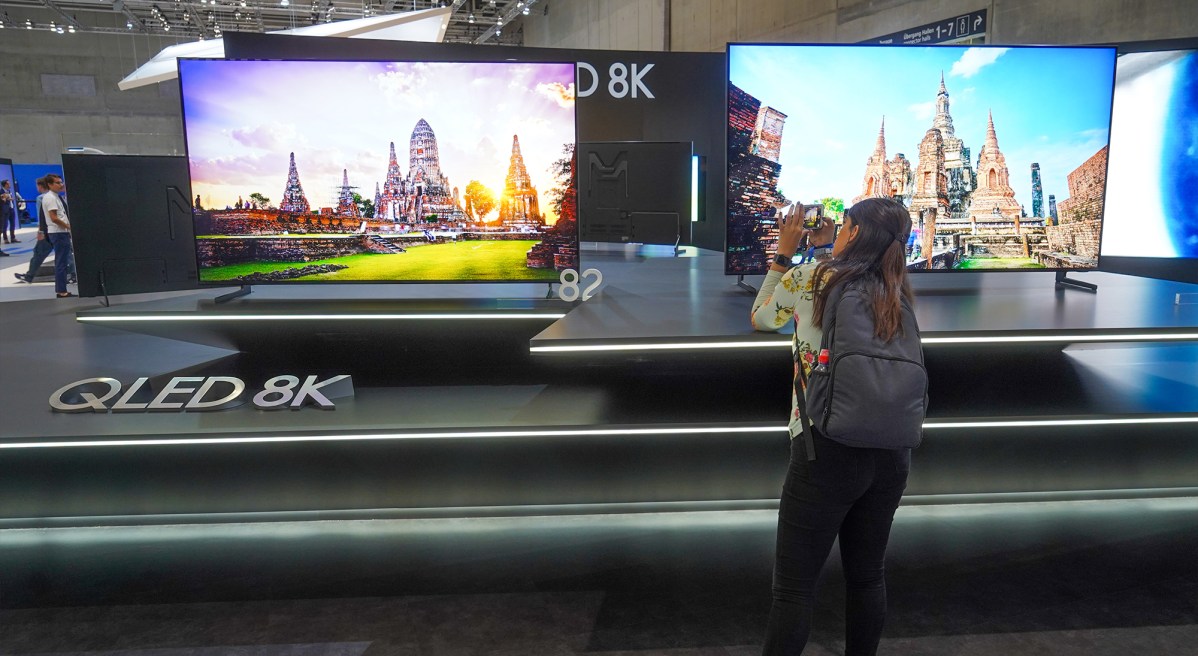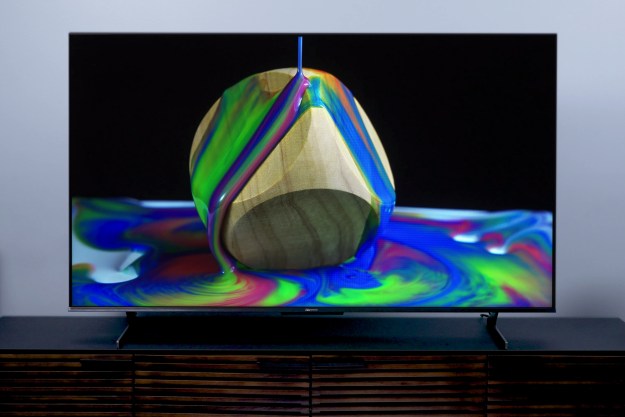8K is the next big thing in TV. At least, that’s how LG, Samsung, Sony, and Sharp would have it. At IFA 2018, Samsung announced it would begin shipping its gorgeous Q900R series series 8K TVs this year. LG arrived with a glorious 88-inch 8K OLED TV. Sony showed off a prototype at CES earlier this year. Sharp is already selling 8K TVs in Japan.
For many movie lovers, the upgrade to an even higher resolution is an exciting idea — but scan the headlines and dig into conversations online and it’s clear there’s also disbelief, frustration, and even anger over this technological development.
8K is here, it is here to stay, and there’s nothing we can do about it.
We just got 4K! There’s no 8K content! What are they thinking? Is my TV about to become obsolete? This is completely unnecessary! All marketing to make us upgrade from our 4K TVs! Make it stop! You can’t see the difference between 4K and 8K. So why even make them?
Folks, calm down. I’m not saying your comments and feelings are invalid. I am saying they are a waste of your emotional and intellectual energy. 8K is here, it is here to stay, and there’s nothing we can do about it. What’s more, 8K TV’s arrival is actually a huge leap forward for us all. Allow me to address all of your concerns, point by point.
We just got 4K!
This is true. If we were to look at a consumer-level TV tech timeline, the arrival of 8K so closely on the heels of 4K is unprecedented. The first HDTV was introduced in 1998, and it wasn’t until 14 years later in October of 2012 that the first 4K UHD TV – the LG 84LM9600 — went on sale in the U.S. If we stick to U.S. sales projections, the first 8K TVs from Samsung are expected to be delivered later this year, closing the gap between the first 4K TVs and the first 8K TVs sold in the U.S. to just 6 years.
The technology behind TV hardware components – from the processors to the display panels – is advancing at a faster clip than ever before as advances build upon those that came before them. You can argue that consumer expectations for newer, faster, flashier tech has never been higher, and therefore the pressure is on manufacturers to deliver on those expectations. But frankly, TV manufacturers have always been coming up with ways to make TVs better, thereby creating more compelling reasons to upgrade. They’re just doing it faster than ever – meaning the next TV you buy will be exponentially better than your current one. How is this is a problem?
This is just a ploy to force us to upgrade!
From thinner bezels and profiles, to 3D TVs and enhanced sound quality, TV makers leverage upgrades to make a buck, no doubt. But the move to 8K isn’t about forcing us to buy something new so they can make more money, it’s about following a trend toward larger displays and making those large displays look their absolute best, meeting an inevitable consumer demand.
Introducing 8K TVs won’t have any impact on 4K TVs other than making them less expensive.
A 120-inch 8K screen viewed from just 7 feet away is going to look sharper than a 4K TV of the same size. It already looks sharper at 85 inches, no matter what human-eye sensitivity calculators say. I’ve seen it up close and the difference is perceivable– and no, I’m not just drinking the Kool-Aid.
Regardless, introducing 8K TVs won’t have any impact on 4K TVs other than making 4K TVs less and less expensive. Nobody is forcing you to buy up to 8K. When 4K TVs are phased out many years from now, it will look just like 1080p TVs getting phased out today – gradual and cost-comparable. Which leads to my next point…
Is my 4K TV about to become obsolete?
No. 1080p TVs aren’t obsolete, though I would argue they are inferior to today’s 4K HDR TVs. 8K resolution is an incremental upgrade over 4K, and valuable only at large screen sizes. Keep in mind that HDR is what really makes today’s TVs pop, and it is only in 65-inch screen sizes and above that 4K resolution is all that meaningful. Still, good luck buying a 1080p TV in any screen size over 40-inches. 4K is just the new standard now, and look, we’re all doing just fine, even if it is harder for some folks to get 4K content.

There’s no 8K content!
True, but there was no 4K content when 4K TVs came out either, and nobody got screwed back then. There’s plenty of it out there now, however; here’s exactly where to find 4K content, if you’re unsure. The bigger problem is 4K content delivery, and I think that is really at the heart of people’s frustrations.
There’s no content now, but 8K TVs are being designed to make everything they play look better on huge screens.
Though there was little HD content available when the first HDTVs rolled off the line, the content came pretty quickly. Broadcasters sorted out HD broadcasts relatively quickly as well, and cable and satellite companies managed to make the transition to digital HDTV delivery within a reasonable amount of time. Unfortunately, the same can’t be said for 4K UHD.
While there are plenty of 4K UHD Blu-ray discs to be enjoyed, and Netflix, Amazon, and YouTube have tons of content available in 4K and 4K HDR, broadcasters and cable/satellite companies have been slow to manage the transition. Most folks have to get 4K content over the internet, and that’s the real problem. Because broadband internet capable of delivering 4K isn’t widely available across the U.S., some folks simply have no access to 4K content.
But that doesn’t mean those people aren’t getting great pictures on their TVs. 4K TVs have upscaling chips that make 720P and 1080P content look much better, and now that processing can fake HDR from non-HDR content, HD images can be made even better.

Apply this to 8K TVs. There’s no content now, but the TVs are being designed to make everything they play look better at huge screen sizes. And, eventually, 8K content will come. There’s already some on YouTube (here, take a peek at Japan in glorious 8K resolution), and 8K broadcast testing has been in the works for years now. It’s only a matter of time – and there’s plenty of that to go around — and the move to the ATSC 3.0 standard, of course.
You can’t see the difference between 4K and 8K.
I beg to differ. While I’ll be the first to admit that the side-by-side 4K vs. 8K TV comparisons I’ve seen are probably manipulated to exaggerate or dramatize improvements, the time I have spent standing in front of 8K TVs has me convinced that, at very large screen sizes, the difference is one most people will be able to appreciate. We can clearly see the difference between 1080p and 4K on a 65-inch TV, and I can personally see it from more than four feet away, no matter what this calculator says.
This isn’t about need. This is about want. We are talking about luxury items, folks.
At 85 or even 88 inches, I think 8K doesn’t have a huge payoff unless you are snuggling up to your TV more than most folks do, but at 100 inches, I have no doubt 8K will offer a convincing payoff, and the benefit will intensify as the screen gets larger. No, 85-inch TVs are nowhere near the norm today, and they may not be in five years, either. But just as 55-inch TVs replaced 42-inch TVs as the most popular size in the U.S. just a few years ago, 65-inch TVs are steadily replacing 55-inchers, and that trend will continue, hard as it may be to imagine.
8K resolution will have its place in the future. Manufacturers are simply getting ready for that inevitability.
This is completely and utterly unnecessary.
Agreed. There is nothing necessary about 8K TV. Or HDR. Or 4K TV. I don’t need another Marvel movie to lead a fulfilled life. And as disappointed as I would be, I’ll live if there isn’t another season of Better Call Saul next year.
This isn’t about need. This is about want. We’re talking about luxury items. This is supposed to be fun and exciting. Can we please go back to that?

Just … why?
Because it’s there. And, in a way, we asked for it.
I want to return to a point I touched on earlier: We – consumers, journalists, investors – put a lot of pressure on manufacturers to come up with something groundbreaking at least once a year in just about every major consumer electronics category. Just look at the hell Apple faces when it doesn’t make the next iPhone mind-blowingly innovative. Brands fear that if they don’t absolutely blow our minds each and every year, they will lose consumer confidence and, as a result, sales. Right or wrong, this is the current state of affairs.
I won’t argue that the move to 8K TV is premature — hell, the move to 4K TV was premature – but I will argue that it doesn’t hurt us, and there’s certainly no valid reason to be upset about it. Let innovation happen, and remember that when companies compete, consumers win. So let’s return to being excited about what the future holds and enjoy sitting back and watching it unfold. Like a really great movie. On a huge 8K TV.
Editors' Recommendations
- Samsung QN900D 8K TV first look: fully loaded flagship
- Denon AVR-X6800H: 8K everywhere and Dirac Live compatibility
- Denon’s small-room 8K AV receivers start at $549
- Samsung debuts Premiere 8K UST projector at CES 2023 with images up to 150 inches
- Samsung’s CES 2023 TVs get thinner, brighter, healthier, and better for gaming




